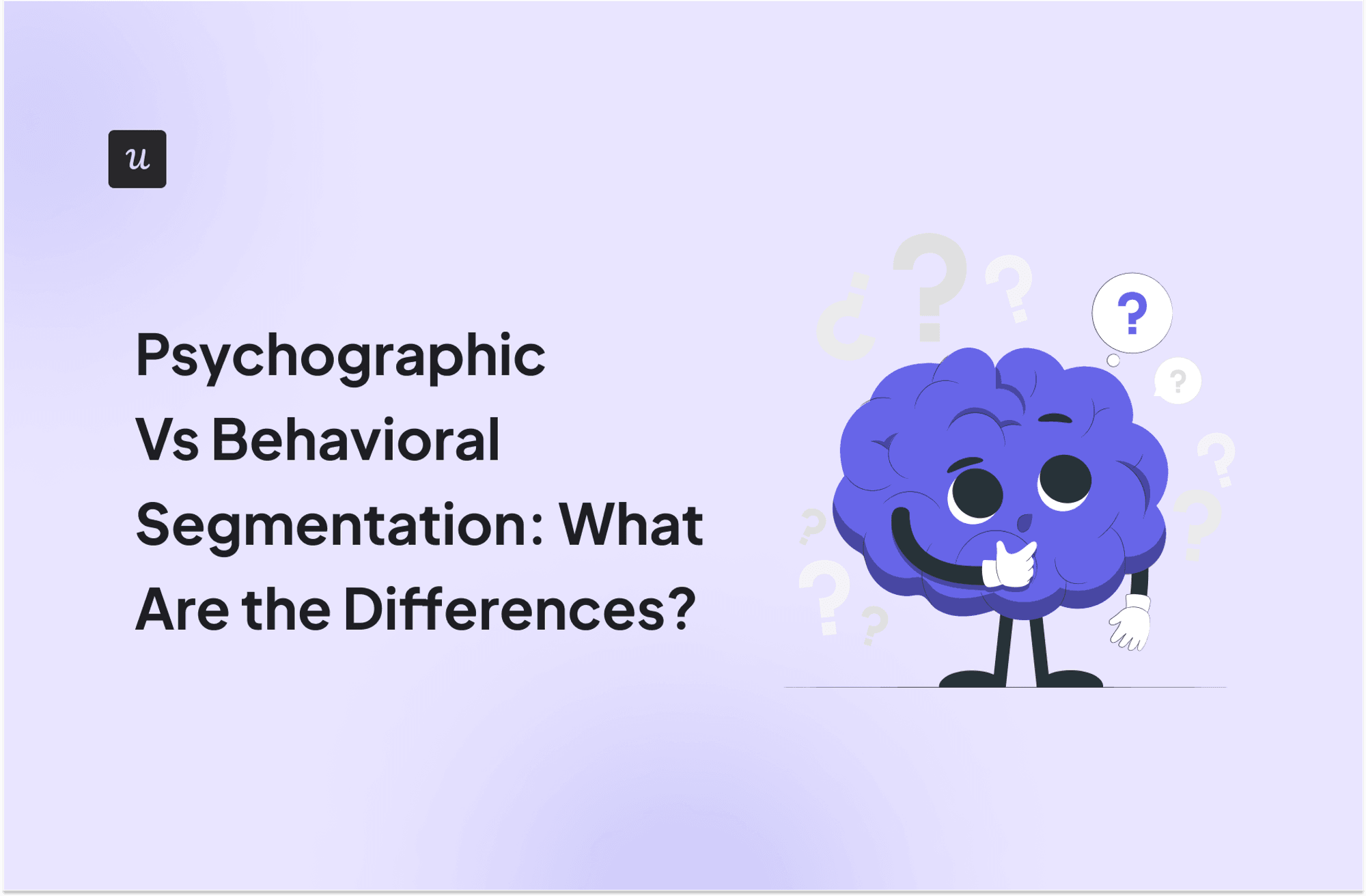
Try Userpilot Now
See Why 1,000+ Teams Choose Userpilot

Psychographic vs behavioral segmentation – summary
- Psychographic segmentation refers to grouping customers based on values, lifestyle, and personality.
- Behavioral segmentation focuses on separating customers into groups based on their actions and interactions within your app. This includes spending habits and usage and activity patterns.
These concepts differ based on the following criteria:
Data collection:
- Use surveys, focus groups, and interviews to collect psychographic data.
- Access analytics tools to track your users’ behavior.
Benefits:
- Use psychographic data to gain deep insights, build targeted marketing campaigns, and develop products that align with your users’ values and beliefs.
- Through behavioral segmentation, you can measure results, use resources efficiently, and personalize user experience.
Limitations:
- Psychographic data can be subjective, complex to analyze, and subject to change.
- Behavioral information has a limited understanding of the user’s motivation, can lead to data overload, and emphasizes current behavior.
Use cases:
- With psychographic segmentation, you can launch targeted marketing campaigns and personalized offers.
- Behavioral information allows you to build personalized product experiences.
- Combine both as psychographic segmentation answers “why” your users act as they do, while behavioral explains “what” they do. This gives you a comprehensive view of your customers.
- Other customer segmentation types include demographic, geographic, needs-based, etc.
- Try Userpilot as your product analytics tool to gather psychographic feedback, track your users’ behavior, and create dynamic audience segments. Get a demo.
What is psychographic segmentation?
Psychographic segmentation divides customers into groups based on their values, lifestyle, personality traits, hobbies, interests, social status, and beliefs.
For example, you can segment customers based on whether they are introverts or extroverts, adventure seekers, eco-conscious people, etc.
This information helps you build more complete customer profiles for each segment.
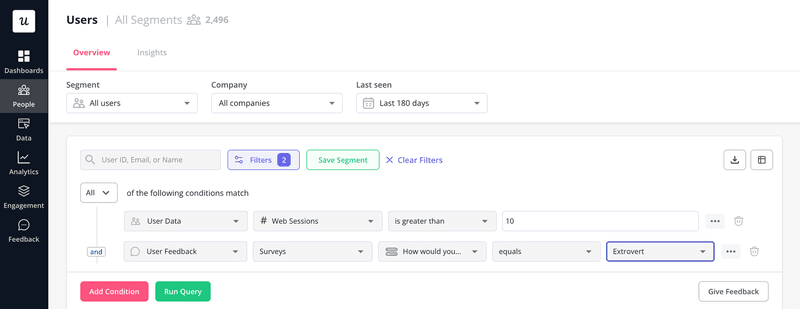
What is behavioral segmentation?
Behavioral segmentation involves separating customers into groups based on how they behave on your platform. You can collect this data by using tools to track user behavior.
Behavioral characteristics include the user’s purchase history, in-app preferences, brand loyalty, customer journey stage, and usage patterns.
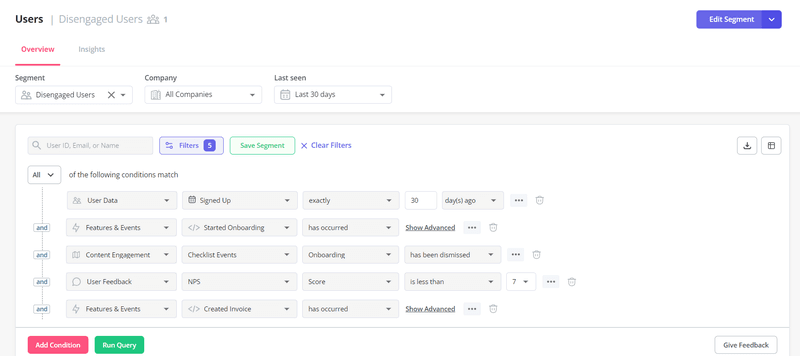
Psychographic vs behavioral segmentation: How they compare
Now that we’ve defined behavioral and psychographic segmentation, let’s take a look at how these two types of user segmentation compare based on different factors:
1. Key variables
Here’s how the variables differ for psychographic and behavioral user segmentation:
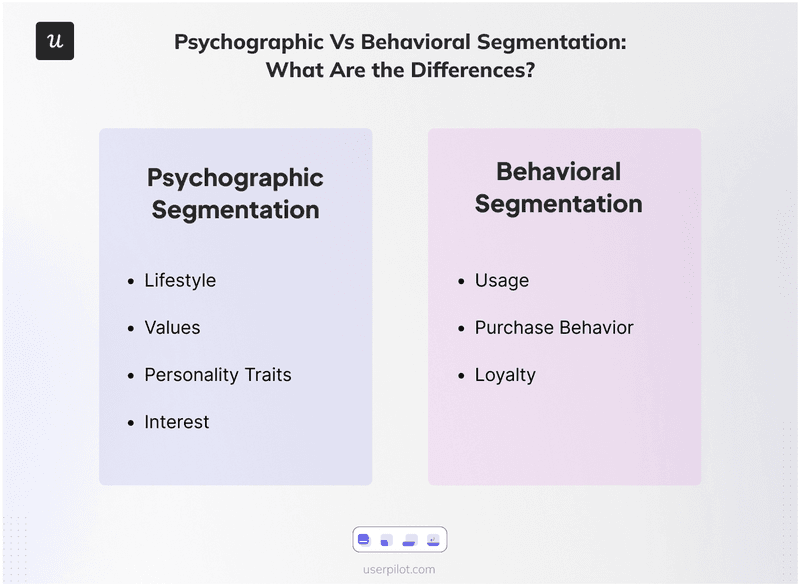
Psychographic data allows you to understand a person’s motivation through these four psychographic segmentation variables:
- Lifestyle: How a person lives their life. Includes habits, attitudes, and daily activities.
- Values: Core principles or beliefs that guide a person’s behavior and decisions.
- Personality: The unique set of characteristics and traits that define someone’s behavior and thinking patterns.
- Interests: Activities, topics, or hobbies that capture a person’s attention.
Behavioral data enables you to conduct a customer behavior analysis and segment users based on these factors:
- Usage: How customers interact with your product, including usage rate, frequency, duration, etc.
- Purchase behavior: How customers buy your product, including the timing, frequency, history, and volume of purchases.
- Loyalty: The degree to which customers consistently choose your company.
2. Data collection methods
To gather psychographic information, conduct:
- User surveys and interviews.
- Focus groups.
- Personality quizzes.
Here, the user research questions should be about personal topics. For example, “What types of activities or hobbies are you passionate about?” or “What are your core personal values or principles?”
To collect behavioral data, use product analytics tools to track user activity, such as:
- Page views or clicks.
- User paths.
- Time on page or session duration.
- Conversions.
- Feature usage.
- In-app purchases.
Analyzing this data allows you to understand how your users behave in your app and trigger in-app interventions based on certain behaviors. For example, if a user is stuck on a page for more than a minute, you can trigger a tooltip to show them how to complete the task.
3. Benefits
The benefits of psychographic segmentation include:
- Deep customer insights: This type of segmentation lets you understand your customers’ underlying motivations, attitudes, and values.
- Improved marketing strategies: Knowing what your customers value and are interested in enables you to create highly targeted marketing campaigns that deeply resonate with them.
- Informed product development: Using psychographic information for segmentation lets you develop features and experiences that align with your customer’s interests and lifestyles.
Behavioral segmentation comes with these benefits:
- Measurable results: As you gain access to clear product metrics, you can easily assess if your assumptions and interventions are yielding the desired results.
- Efficient resource allocation: After reviewing the data, you can focus on the initiatives that drive the most impact, reducing unnecessary time or budget spending.
- Personalized customer experience: Trigger in-app messages, interventions, and marketing campaigns based on your users’ specific behaviors.
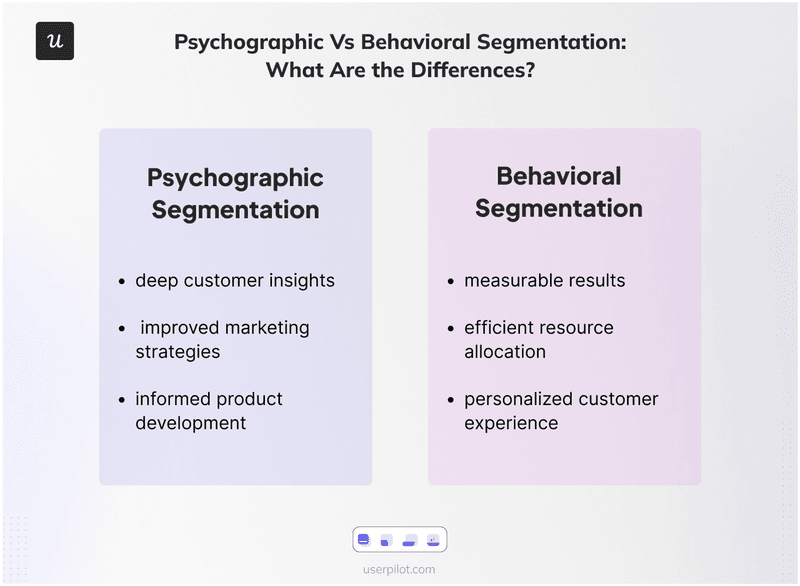
4. Limitations
While psychographic and behavioral segmentation can help you improve brand loyalty and build more personalized experiences, there are also limitations to consider.
Psychographic limitations include:
- Subjectivity in data collection since you often need to rely on self-reported survey and interview answers.
- Complexity and cost because qualitative user research methods such as focus groups can be time-consuming and expensive.
- The data’s dynamic nature as people can change their lifestyles, interests, and values over time, so you’ll need to conduct periodic research.
- Difficulty to quantify data because psychographic attributes like personality and values are abstract concepts.
Behavioral limitations include:
- Limited understanding of user motivations since the data doesn’t necessarily tell you why a user behaves the way they do.
- Data overload as it can be overwhelming to extract actionable insights from an immense and complex database.
- Limited predictability as behavioral segmentation focuses on past and current behavior, which may not always predict future actions.
5. Use cases
Here are practical use cases and customer segmentation examples.
Psychographic segmentation examples:
You can use psychographic segmentation to create targeted marketing campaigns that align with your customers’ lifestyles, interests, and values.
For example, as a travel agency, you could use psychographic data to identify thrill-seekers and adventure enthusiasts. Then, craft campaigns highlighting exotic destinations and thrilling activities that speak to users’ adventurous spirit.
Another use case involves personalized offers.
For example, if you offer banking or financial services, you could use psychographic data to segment customers based on risk tolerance. Then, offer high-risk tolerance investors opportunities with potential high rewards, while providing low-risk investors with safer, more stable options.
Behavioral segmentation examples:
Behavioral segmentation data allows you to provide personalized offers and content based on customer actions.
For instance, as an online retailer, you could segment customers based on buying frequency, purchase value, and product categories.
You can then identify high-value customers who frequently purchase electronics and offer them exclusive deals on the latest gadgets. As an online retailer, you could also share personalized recommendations with customers based on past purchases.
Another common use case for behavioral segmentation is improving customer retention. As a streaming service, you could track viewing habits to present each user with tailored content suggestions. By catering to users’ preferences, you can encourage engagement and reduce churn.
Psychographic and behavioral segmentation: Why you need both
Behavioral user segmentation tells you exactly what your customers do when they use your product. Psychographic segmentation, on the other hand, explains why they behave the way they do.
This combination lets you conduct a comprehensive customer segmentation analysis with both quantitative and qualitative data.
Other types of market segmentation
Apart from analyzing your customers’ behaviors and beliefs, you can also benefit from these types of segmentations:
Demographic segmentation
Separate your customers based on factors such as:
- Age.
- Income.
- Occupation.
- Gender.
- Marital status.
- Education.
Geographic segmentation
Group your customers based on their location and use this data to localize your content and user experience.
Needs-based segmentation
Needs-based segmentation divides customers based on their specific needs or problems they want to solve with your product.
For example, a financial services company can segment clients based on their financial goals, such as retirement planning, wealth management, or debt reduction. Each segment can receive personalized financial advice and product recommendations that cater to their needs.
Psychographic and behavioral segmentation: How Userpilot helps
Userpilot is a no-code, all-in-one product-led growth tool that can help you:
- Collect psychographic and behavioral data.
- Create customer segments.
- Auto-capture how different segments behave.
- Build and trigger in-app guidance for different segments.
- A/B test ideas to build the best potential experience for each customer segment.
Here’s how to do some of these:
Collect feedback for psychographic segmentation
Build and launch in-app surveys with Userpilot to discover information about your customers, including goals, values, and preferences. Use the answers to build psychographic segments.
When building a survey, you can choose one from our vast survey template library and customize it to your liking or create one from scratch. Since Userpilot is a no-code customer feedback tool, anyone in your team can make, edit, and launch surveys without any hassle.
You can also toggle the localization option to show the survey in other languages depending on where the user is accessing the tool. Make sure to include a mix of open- and close-ended questions for more comprehensive answers.
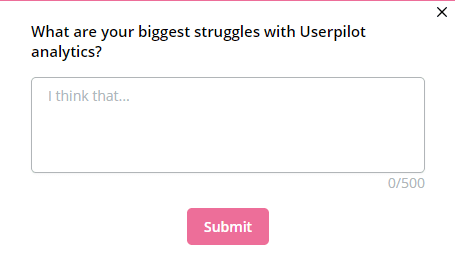
Analyze user behavior for behavioral segmentation
Userpilot is a product analytics tool that lets you build user behavior reports, such as:
- Trends reports. Conduct a trend analysis to understand how users perform certain actions.
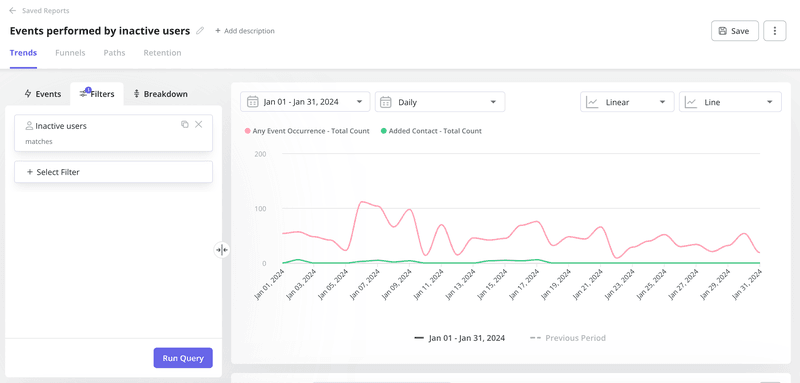
- Funnel report. See how your customers behave and move through the funnel. Use this to identify friction points.
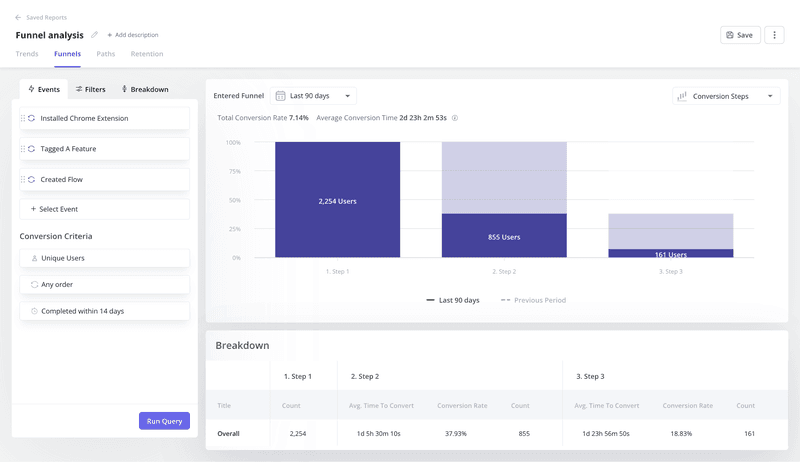
- Retention report. Through a retention analysis, you can see how well you’re retaining customers over time.
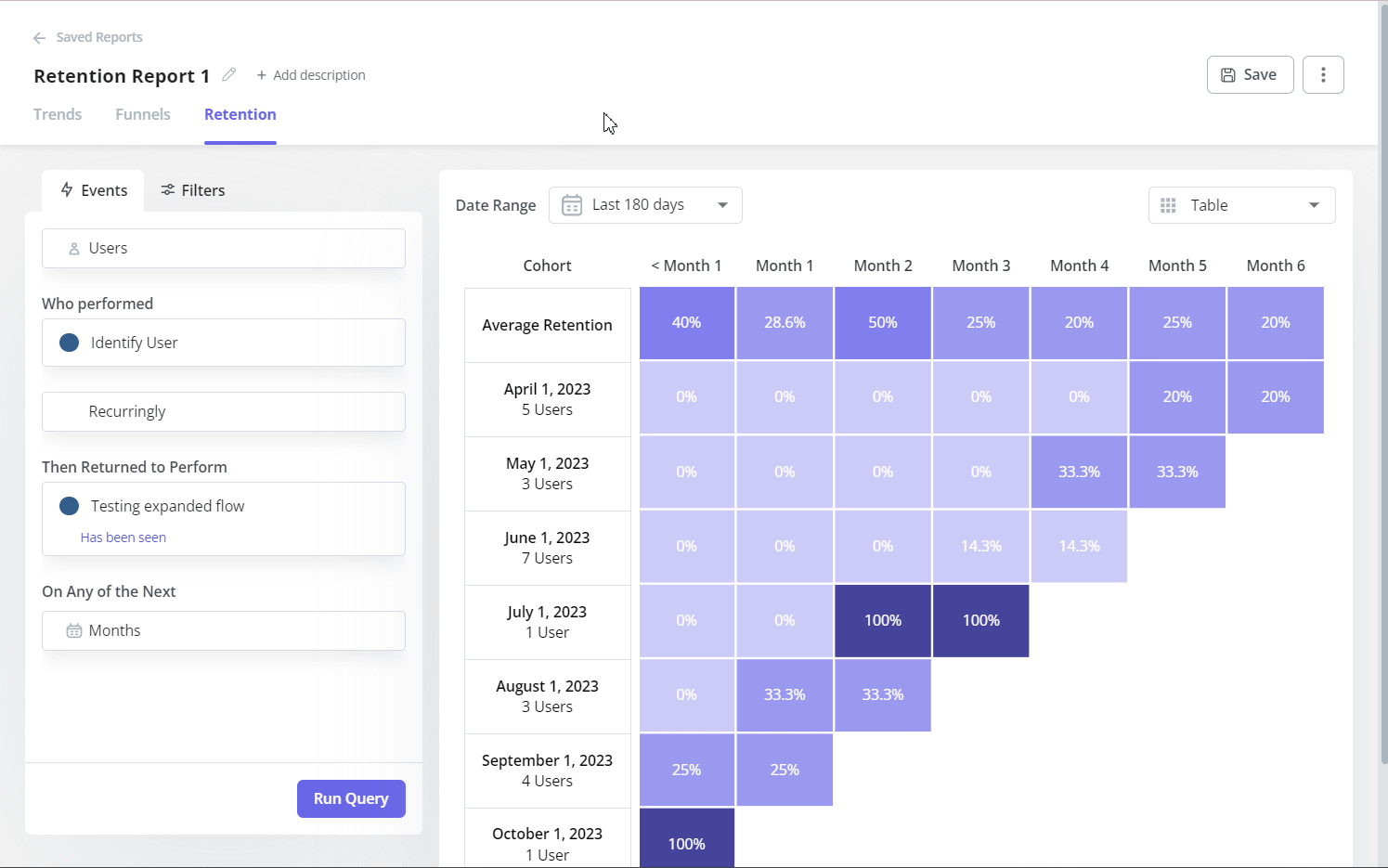
- Path analysis report. Track and analyze the steps a user takes when navigating your app.
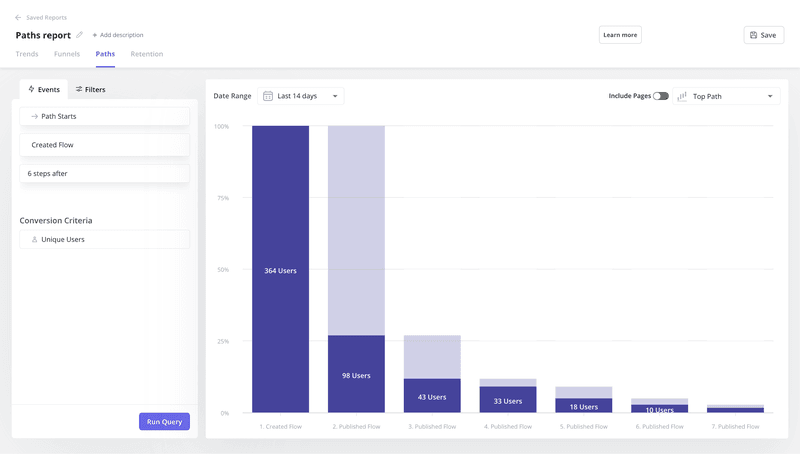
Create customer segments
Userpilot allows you to easily create user segments by going to the “People” tab and adding properties.
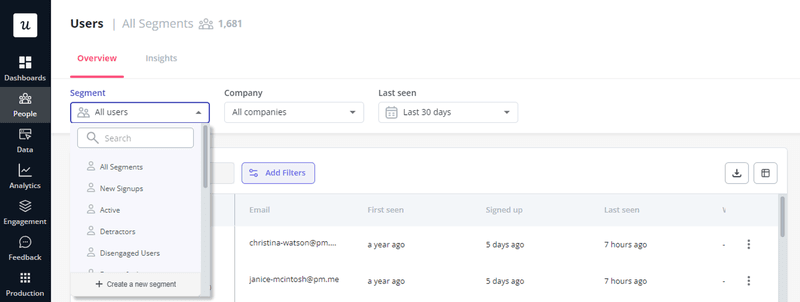
Then, add conditions for advanced segmentation.

For example, segment customers by plan, role, and answers in a survey. You can then track how each segment performs certain events.
Conclusion
Using both psychographic and behavioral segmentation provides a complete view of your customer’s motivations and actions.
This dual approach enables more targeted marketing strategies, informed product decisions, and enhanced customer engagement.
Userpilot allows you to collect and analyze psychographic and behavioral data, create customer segments, and launch personalized in-app experiences for each segment. Try it for yourself – get a demo now!







